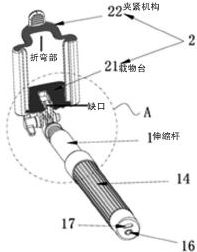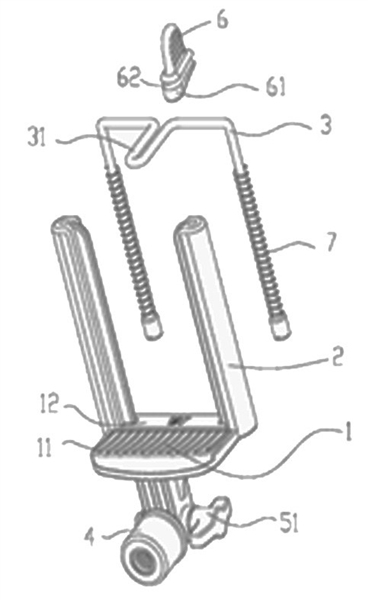Creative judgment of utility model patent

Patent involved



editorial comment/note
Recently, a series of requests for invalidation for the utility model patent of "Integrated Self-timer Device" of Yuandesheng have attracted wide attention in the industry. To this end, this newspaper specially invites experts to clarify the relevant examination standards and principles in the patent invalidation procedure in combination with the focus of controversy in the case, and explore why the patent is "invalid", in order to help enterprises improve the quality of patents and improve the level of protection.
Creativity is one of the substantive conditions for an invention to be granted a patent right, and it is the legal issue with the highest proportion involved in the substantive examination of patent application, patent invalidation procedure and patent administrative cases, so its examination standard has also become the most concerned issue for patent applicants or patentees, courts and even the public.
Fact finding in creative judgment
In the examination practice, because the utility model patent involves the specific structure of the product, it is difficult to avoid the comparison between the specific technical features of the technical scheme when comparing the features. If the specific technical features are isolated and the integrity of the technical scheme is split in the comparison process, simply and mechanically comparing the words will lead to unclear facts and affect the conclusion of the examination. This problem is fully reflected in a series of patent invalidation request cases of "integrated selfie device", and objectively and accurately identifying the facts is the basis for the case to draw a correct conclusion.
In the case of a series of patent invalidation requests for "integrated selfie device", the core technical content of the patent involved is that "the stage is provided with a notch, the clamping mechanism is provided with a bending part corresponding to the notch position, and the telescopic rod can be accommodated in the notch and the bending part after being folded", which is recorded in Claim 2 of the patent involved. The claim defines that the notch on the object table corresponds to the bending part on the clamping mechanism, and the notch and the bending part form a space for accommodating the folded telescopic rod, which saves more space for accommodating the selfie stick and realizes the beneficial effect of convenient carrying. During the trial of the case, whether the above-mentioned bending part was made public by the existing technology became the focus of dispute between the two parties. The author will analyze how to identify the fact that the comparison document was made public from two aspects.
1. Comparison of features with the same words.
In one of the requests for invalidation, the claimant used the utility model patent with the invention name "A shooting device clamping device of hand-held remote control shooting device" as evidence (hereinafter referred to as Evidence 1) to comment on the creativity of Claim 2. The petitioner thinks that Evidence 1 discloses that the clamping structure includes a movable rod 3, both ends of which are arranged in two supporting arms in a stretchable manner, and the middle part of which is provided with a bending structure 31, and the bending mechanism 31 is located above the objective table, that is, Evidence 1 discloses the technical scheme of setting a bending part on the clamping mechanism.
Through careful analysis of the contents disclosed in Evidence 1, it is not difficult to find that the middle opening of the bending structure in Evidence 1 is used to engage with the groove on the handle, and the handle is fixed in the middle of the movable rod to facilitate the up-and-down movement of the movable rod, thus clamping the shooting equipment. This is completely different from the function and function of the bending part in the patent involved: the bending part of the patent involved has a U-shaped opening, which together with the notch on the stage forms a storage space for accommodating the folded telescopic rod, thus realizing the miniaturization and portability of the selfie stick. Therefore, although the bending structure in Evidence 1 is similar to the bending part of the patent involved in the case in terms of words and structure, the bending structure in Evidence 1 is used for coupling with the handle, and after it is fixedly connected with the handle, it no longer has any space and cannot be used for storage. Therefore, it can’t be considered that Evidence 1 discloses the bending part of the patent involved, and it doesn’t give the technical enlightenment for its acceptance.
2. Identification of the public contents of the attached drawings
In another request for invalidation, the claimant used a patent for utility model named "a hand-held remote control device for shooting" as evidence (hereinafter referred to as Evidence 2), and once again commented on the creativity of Claim 2. The petitioner believes that Figure 5 of Evidence 2 shows that the end of the fixing frame is provided with a bending part with a large opening, which is the bending part involved in the patent involved.
In patent application documents, the appended drawings are an integral part of the specification, and their function is to supplement the description of the text part of the specification with graphics, so that people can intuitively and vividly understand each technical feature and the overall technical scheme of the invention or utility model. However, only the technical features that can be directly determined from the attached drawings are public contents, and the contents inferred from the attached drawings should not be regarded as public contents.
Attached Figure 5 of Evidence 2 shows the schematic diagram of the connection between the mobile phone holder and the remote control shooting device, in which the mobile phone holder includes a holder and a connecting platform, the holder is used for placing the shooting device, and the connecting platform is used for connecting with the remote control shooting handle. Figure 5 does show that there is a bending part with the same structure as the patent involved in the case in the middle of the fixing frame, but there is no explanation about this bending part in the description of Evidence 2, and according to the analysis and understanding of the full text of Evidence 2, it can be judged that this bending part cannot be used to form a storage space, because the mobile phone fixing frame in Evidence 2 is connected with the remote control handle through the first connecting part, which is a threaded connector. The remote control handle connected by thread can’t be folded, and Evidence 2 doesn’t need to solve the storage space problem in the process of folding the selfie stick, so the setting of the bending part can’t be to solve the technical problems to be solved by the patents involved. Therefore, only on the basis of the structure shown in Figure 5 of Evidence 2, the technicians in this field can’t directly and undoubtedly determine that this structural feature can achieve the same effect as the bending part in the patent involved, and Evidence 2 does not disclose the bending part in Claim 2.
In a word, accurate fact finding is an important basis for correct feature comparison and objective review conclusion. The fact that the technical scheme disclosed in the prior art cannot be simply taken out of context, but should be considered from the perspective of the technical personnel in this field as a whole, and the technical characteristics and functions of the technical scheme should be considered as a whole, so as to accurately compare the characteristics and objectively judge the creativity of the claim. That is to say, for the technical features that support each other in function and have an interactive relationship, the technical features should be considered as a whole.
Influence of protection scope on creativity
The scope of protection of the patent right should match the technological contribution of the invention-creation. If the scope of protection is too large, it obviously exceeds the technological contribution of the invention-creation, which will easily lead to the invalidation of the claim because it is not creative at the stage of invalidation request.
As far as the case of patent invalidation request for "integrated self-timer device" series is concerned, first of all, independent claim 1 defines a larger scope. In independent claim 1, the preamble defines the characteristics of the usual self-timer device, including the telescopic rod and the clamping device, which includes the objective table and the stretchable clamping mechanism, and the connection relationship between the telescopic rod and the clamping device is defined in the characteristic part. That is, "the clamping device is integrally connected to the top end of the telescopic rod", which embodies the difference from the background technology. However, in the trial process of invalidation, it was disclosed by the prior art because it covered a large protection range, so it was declared invalid.
Secondly, the dependent claim 2 embodies the main innovation of the patent involved, that is, the notch on the stage and the bending part corresponding to the notch on the clamping mechanism form a space for accommodating the folded telescopic rod, and the telescopic rod can be directly accommodated in the notch on the stage and the bending part of the clamping mechanism after use, which can solve the technical problems of better accommodating the selfie stick and being convenient to carry. The remaining dependent claims 3-13 refer to claim 2 directly or indirectly, so that even if claim 1 is invalid due to too large a scope of protection, other dependent claims 3-13 can remain valid while dependent claim 2 remains valid.
To sum up, combined with the problem of fact finding in creative judgment, this paper focuses on the analysis of the reasons why Claim 2 was kept valid in the series of cases of "self-timer" invalidation request. Because Claims 3-13 directly or indirectly quoted Claim 2, Claims 2-13 were declared to be kept valid, which benefited from the patent involved’s well-defined patent layout, which reasonably determined the protection scope of the claim.
From the perspective of patent layout, the patents involved are based on a single technical point to construct a combination of claims to effectively protect innovative technologies. Although it is only a single technical point, the layout of claims takes into account the main innovation points, necessary technical characteristics, singleness and other factors, taking into account the principle of layered protection, narrowing the protection scope of claims layer by layer, and the layout ideas are clear and reasonable.
(Song Zuozhi Su Qing Author: Patent Reexamination Board of the State Intellectual Property Office)